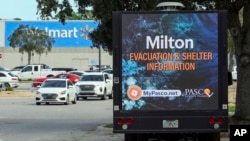The southeastern U.S. state of Florida braced Wednesday for the arrival of powerful Hurricane Milton amid warnings of heavy rains, strong winds and life-threatening storm surge.
Forecasters said the center of the storm was expected to make landfall Wednesday night along Florida’s west-central coast. That region includes Tampa Bay, a city of 3.3 million people that has not taken a direct hit from a hurricane since 1921.
“Milton has the potential to be one of the most destructive hurricanes on record for west-central Florida,” the U.S. National Hurricane Center said.
There was particular concern about storm surge, the rise in water level driven mainly by the storm’s powerful winds as it pushes into the coast. The hurricane center said storm surge levels could hit 3-4.5 meters in areas near where the eye of the storm comes ashore.
Storm surge warnings were in effect Wednesday for nearly the entire west coast of the Florida peninsula, spanning 500 kilometers.
Roads were busy Monday and Tuesday as people followed mandatory and voluntary evacuation orders to escape the hurricane’s path, while those choosing to stay made final preparations to endure the storm.
The hurricane had maximum sustained winds of about 260 kilometers per hour late Tuesday, making it a Category 5 storm on the five-level Saffir-Simpson scale. Storms of that magnitude are expected to cause widespread destruction and damage to homes and long-lasting power outages.
The National Hurricane Center said areas in central and northern Florida were expected to receive 15-30 centimeters of rainfall, with higher amounts in some locations. The storm is expected to cross Florida and enter the Atlantic Ocean on Thursday.
“Evacuate now, now, now,” U.S. President Joe Biden advised Florida residents Tuesday from the White House. The president has canceled trips this week to Germany and Angola to remain in the U.S. to oversee preparations for and response to Milton, the White House said.
Milton will likely be “a monster,” Florida Governor Ron DeSantis said Tuesday. He urged Florida residents to pay attention to the reports of weather forecasters and to adhere to local evacuation orders.
The governor said Florida is set to activate 8,000 National Guard members to help with Milton’s aftermath.
Dozens of emergency shelters are ready for people who need them, with one location in Florida able to hold 10,000 people, according to the governor. However, DeSantis said that the shelters are “designed to be a shelter of last resort.”
Milton’s arrival in Florida comes just two weeks after Hurricane Helene hit the state. DeSantis said Tuesday that Florida Department of Transportation trucks have removed 1,300 truckloads of Helene’s debris in a little over 48 hours. He said taking away such a “huge, huge amount” of debris will prevent further damage.
Some information for this report came from Reuters, The Associated Press and Agence France-Presse.



